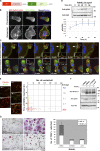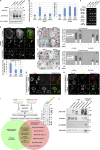Tks5-dependent formation of circumferential podosomes/invadopodia mediates cell-cell fusion
- PMID: 22584907
- PMCID: PMC3352951
- DOI: 10.1083/jcb.201111116
Tks5-dependent formation of circumferential podosomes/invadopodia mediates cell-cell fusion
Abstract
Osteoclasts fuse to form multinucleated cells during osteoclastogenesis. This process is mediated by dynamic rearrangement of the plasma membrane and cytoskeleton, and it requires numerous factors, many of which have been identified. The underlying mechanism remains obscure, however. In this paper, we show that Tks5, a master regulator of invadopodia in cancer cells, is crucial for osteoclast fusion downstream of phosphoinositide 3-kinase and Src. Expression of Tks5 was induced during osteoclastogenesis, and prevention of this induction impaired both the formation of circumferential podosomes and osteoclast fusion without affecting cell differentiation. Tyrosine phosphorylation of Tks5 was attenuated in Src-/- osteoclasts, likely accounting for defects in podosome organization and multinucleation in these cells. Circumferential invadopodia formation in B16F0 melanoma cells was also accompanied by Tks5 phosphorylation. Co-culture of B16F0 cells with osteoclasts in an inflammatory milieu promoted the formation of melanoma-osteoclast hybrid cells. Our results thus reveal an unexpected link between circumferential podosome/invadopodium formation and cell-cell fusion in and beyond osteoclasts.
Figures







Similar articles
-
Orthodontic compressive force modulates Ets-1/Tks5 pathway to promote the formation of circumferential invadopodia and the fusion of osteoclast precursors.J Cell Physiol. 2019 Aug;234(8):12685-12691. doi: 10.1002/jcp.27879. Epub 2018 Dec 6. J Cell Physiol. 2019. PMID: 30523634
-
A role for the podosome/invadopodia scaffold protein Tks5 in tumor growth in vivo.Eur J Cell Biol. 2008 Sep;87(8-9):555-67. doi: 10.1016/j.ejcb.2008.02.008. Epub 2008 Apr 15. Eur J Cell Biol. 2008. PMID: 18417249 Free PMC article.
-
The role of Tks adaptor proteins in invadopodia formation, growth and metastasis of melanoma.Oncotarget. 2016 Nov 29;7(48):78473-78486. doi: 10.18632/oncotarget.12954. Oncotarget. 2016. PMID: 27802184 Free PMC article.
-
Advances in Understanding TKS4 and TKS5: Molecular Scaffolds Regulating Cellular Processes from Podosome and Invadopodium Formation to Differentiation and Tissue Homeostasis.Int J Mol Sci. 2020 Oct 30;21(21):8117. doi: 10.3390/ijms21218117. Int J Mol Sci. 2020. PMID: 33143131 Free PMC article. Review.
-
Podosome and sealing zone: specificity of the osteoclast model.Eur J Cell Biol. 2006 Apr;85(3-4):195-202. doi: 10.1016/j.ejcb.2005.09.008. Epub 2005 Oct 24. Eur J Cell Biol. 2006. PMID: 16546562 Review.
Cited by
-
Symmetrical retrograde actin flow in the actin fusion structure is involved in osteoclast fusion.Biol Open. 2017 Jul 15;6(7):1104-1114. doi: 10.1242/bio.025460. Biol Open. 2017. PMID: 28711870 Free PMC article.
-
Regulation of ECM degradation and axon guidance by growth cone invadosomes.Development. 2015 Feb 1;142(3):486-96. doi: 10.1242/dev.108266. Epub 2015 Jan 6. Development. 2015. PMID: 25564649 Free PMC article.
-
An improved metrics for osteoclast multinucleation.Sci Rep. 2018 Jan 29;8(1):1768. doi: 10.1038/s41598-018-20031-x. Sci Rep. 2018. PMID: 29379067 Free PMC article.
-
A viral fusogen hijacks the actin cytoskeleton to drive cell-cell fusion.Elife. 2020 May 22;9:e51358. doi: 10.7554/eLife.51358. Elife. 2020. PMID: 32441254 Free PMC article.
-
Phosphoglycerol dihydroceramide, a distinctive ceramide produced by Porphyromonas gingivalis, promotes RANKL-induced osteoclastogenesis by acting on non-muscle myosin II-A (Myh9), an osteoclast cell fusion regulatory factor.Biochim Biophys Acta Mol Cell Biol Lipids. 2017 May;1862(5):452-462. doi: 10.1016/j.bbalip.2017.01.008. Epub 2017 Jan 31. Biochim Biophys Acta Mol Cell Biol Lipids. 2017. PMID: 28153611 Free PMC article.
References
-
- Andersen T.L., Boissy P., Sondergaard T.E., Kupisiewicz K., Plesner T., Rasmussen T., Haaber J., Kølvraa S., Delaissé J.M. 2007. Osteoclast nuclei of myeloma patients show chromosome translocations specific for the myeloma cell clone: a new type of cancer-host partnership? J. Pathol. 211:10–17 10.1002/path.2078 - DOI - PubMed
Publication types
MeSH terms
Substances
LinkOut - more resources
Full Text Sources
Other Literature Sources
Molecular Biology Databases
Miscellaneous

